#Ghost stories in Japanese literature
Text
Jikan no Mukou,or The Other Side of Time: Tales for a Time Being and other Ghostly Experiences in Chinese and Japanese Literature. jikan no mukou,
Tales for a Time Being is a captivating and poignant novel written by Ruth Ozeki. The book has been praised for its intricate plot, vivid characters, and insightful commentary on cultural themes. In this review, I will explore the cultural elements, hidden motifs, and zeitgeist of the book while also drawing comparisons to Japanese and Chinese ghost stories from the 16th and 17th centuries.
The…

View On WordPress
#Anime and manga#banana yoshimoto#Contemporary Japanese literature#Geisha culture#Ghost stories in Japanese literature#haruki murakami#Japanese architecture#Japanese calligraphy#Japanese ceramics#Japanese cuisine#japanese culture#Japanese fashion#japanese folklore#japanese gardens#japanese history#japanese literature#japanese mythology#Japanese philosophy#Japanese pop culture#Japanese tea ceremony#Japanese traditional music#Kabuki theater#Kawaii culture#Noh theater#Sake#Samurai culture#shintoism#Tokyo fashion#Yoko Ogawa#Zen Buddhism
1 note
·
View note
Text

The Summer of the Ubume, Natsuhiko Kyogoku
#ghosts#quotes#ghost stories#the summer of the ubume#ubume no natsu#Natsuhiko Kyogoku#japanese literature#honhaku mystery#detective fiction#yokai#kyogokudo#akihiko chuuzenji#literature
3 notes
·
View notes
Text
sad bc i feel like im in japanese literature specialization with people who are uninterested at best and hating it all at worst. literature is cool, reading stuff you wouldnt pick up on your own is great sometimes and finding meaning behind the words is just... a crazy experience. why are you even here if you just want to complain that people write their feelings and struggles out in allegories and symbols...
#hakuna matata#i have japanese lit class again tomorrow#and im really enjoying the book i was given to read#its a collection of traditional ghost stories rewritten from a female/feminist perspective (where the wild ladies are by matsuda aoko)#and i hate attending this class and giving my silly little presentations and explaining what this book means to me#knowing that like... nobody else is this enthusiastic about their own books.#im convinced they think im a lunatic anyway for many reasons#it just sucks. the one class where i really get to do work im interested in. and nobody else gives a shit.#especially that one guy#why are you studying humanities why are you studying japanese literature if you refuse to think of mankind as more than cold unfeeling logi#i havent hated being around someone this much in a very long time
2 notes
·
View notes
Text
Consulting the convoluted history of supernatural foxes, or why is Tsukasa like that

I know I said you should only expect one long Touhou-themed research article per month, and that the next one will be focused on Ten Desires, but due to unforeseen circumstances a bonus one jumped into the queue. For this reason, you will unexpectedly have the opportunity to learn more about the historical and religious context of the belief in kuda-gitsune, or “tube foxes”, as well as their various forerunners. Tsukasa is clearly topical thanks to Unfinished Dream of All Living Ghost, and I basically skipped covering Unconnected Marketeers in 2021 save for pointing out some banal tidbits, so I hope this is a welcome surprise.
The post contains spoilers for the new game, obviously.
Obviously, in order to properly cover the kuda-gitsune, it is necessary to start with a short history of foxes in Japanese culture through history, especially in esoteric Buddhism.
Early history: the Chinese background
Early Japanese sources pertaining to foxes show strong Chinese influence. There was an extensive preexisting system of fox beliefs to draw from in continental literature, dating back at least to the Han dynasty (note that while the well known story of Daji is set much earlier, its modern form only really goes back to the Song dynasty). This is way too complex of a topic to discuss here in full, sadly, so I will limit myself to the particularly interesting tidbits.

A multi-tailed fox in the classic Chinese encyclopedia Gujin Tushu Jicheng (wikimedia commons)
It will suffice to say that historically the fox was perceived in China as a liminal being, and could be associated with pursuits regarded as ethically dubious, ranging from theft and banditry to instigating rebellions and promoting divisive religious views (so, for example during the reigns of firmly pro-Taoist emperors, Buddhist monks could be associated with foxes). Literary texts focused on supernatural foxes emphasized their shapeshifting abilities. In contrast with some of the other well attested supernatural beings in Chinese tradition, they could take a range of human forms, appearing as men and women of virtually any age. Often they favored mimicking people who lived on the margins of society, like bandits, courtesans or migrant laborers. It was also emphasized that they displayed a considerable degree of disregard for authority. The fact these animals lived essentially alongside humans without being domesticated definitely played a role in the formation of this image.
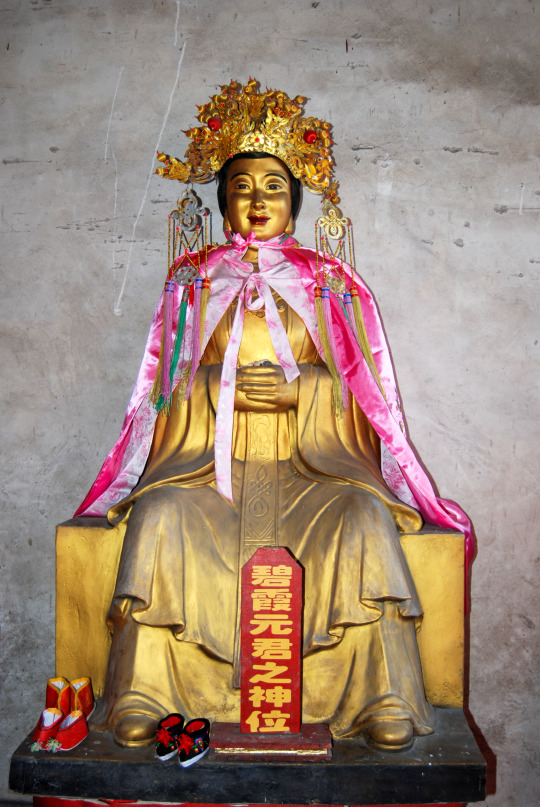
A contemporary statue of Bixia, a deity in the past associated with fox beliefs (wikimedia commons)
At the same time, foxes enjoyed a degree of popularity as objects of semi-official cult, still practiced here and there in China in modern times, for example in Boluo in Shaanxi. The religious role of foxes was reflected in, among other things, the development of terms like hushen (狐神) “fox deity”, or huxian (狐仙), “fox immortal”. The belief in such “celestial foxes” (tianhu, 天狐) was relatively common, and there is even a legend according to which there was a formalized way for the animals to transcend to higher states of existence, with the goddess Bixia making them undergo the supernatural fox version of the well known imperial examinations. If they failed they were condemned to live as “wild foxes” (yehu, 野狐) with no hope of transcendence. There are also accounts of foxes pursuing the status of a xian through illicit means, through a combination of praying to the Big Dipper and draining people’s energy, as documented by He Xiu in the 1700s. Note foxes were already portrayed as worshiping the Big Dipper during the reign of the Tang dynasty, but back then it was only believed this let them transform into humans.
The ambiguity of foxes is evident in the Japanese perception of these animals too. Supernatural foxes are probably among the best known youkai, and especially considering this is a post about Touhou I do not think the basics need to be discussed in much detail. They were believed to shapeshift and to steal vital energy, much like in China. Their positive role as messengers of Inari, a kami associated with agriculture, is generally well known too.
The earliest sources documenting encounters with supernatural foxes are obviously, as expected, the earliest chronicles like the Nihon Shoki, where they mostly appear as omens. By the Heian period these animals are well established in the written record. For instance, Nakatomi Harae Kunge includes “evil magic due to heavenly and earthly foxes” among phenomena which require ritual purification. In addition to the tales imported from China being in circulation, some setsuwa written in Japan involved shape shifting foxes. However, supernatural foxes only gained greater prominence in the Japanese middle ages due to the growth of relevance of two deities they were associated with, Inari and Dakiniten. The latter is more relevant to the topic of this article.
Foxes, Dakiniten and tengu

Part of a hanging scroll depicting Dakiniten riding on a fox (wikimedia commons, via MET; cropped for the ease of viewing)
The connection between foxes and Dakiniten reflected their associations with the dakinis, a class of demons in Buddhism. Originally the dakinis were associated with jackals instead, but Chinese Buddhist authors presumed that the animal mentioned in this context is basically identicial with more familiar foxes, and that belief reached Japan as well. It was strong enough for Dakinite, the dakini par excellence, to be regularly depicted riding on the back of a fox.
Dakiniten was originally a regular dakini, according to Bernard Faure specifically one who appears in Heian period Enmaten mandalas (Enmaten is related to but not quite the same as the better known king Enma, for the development of two distinct reflections of Yama in Buddhism see here). However, she eventually developed into a full blown deva in her own right, and her prominence was so great that it basically resulted in the decline of references to the generic dakinis in Buddhist literature in Japan. She was particularly popular in the Shingon school of Buddhism, and at the peak of her relevance played a role in royal ascension rituals, developing a connection with Amaterasu in the process (Amaterasu acquired many peculiar connections through the Japanese middle ages, it was par the course). A Tendai treatise equates her with Matarajin instead, though.
An interesting phenomenon related to Dakiniten is the occasional fusion of beliefs pertaining to foxes and tengu, which might have originated in the similarity of the terms tengu and the Japanese term for the already mentioned “heavenly foxes”, tenko. Its best attested examples include the inclusion of tengu in mandalas focused on Dakiniten as her acolytes. However, a different deity ultimately exemplifies this even better.
Iizuna Gongen and "iizuna magic"
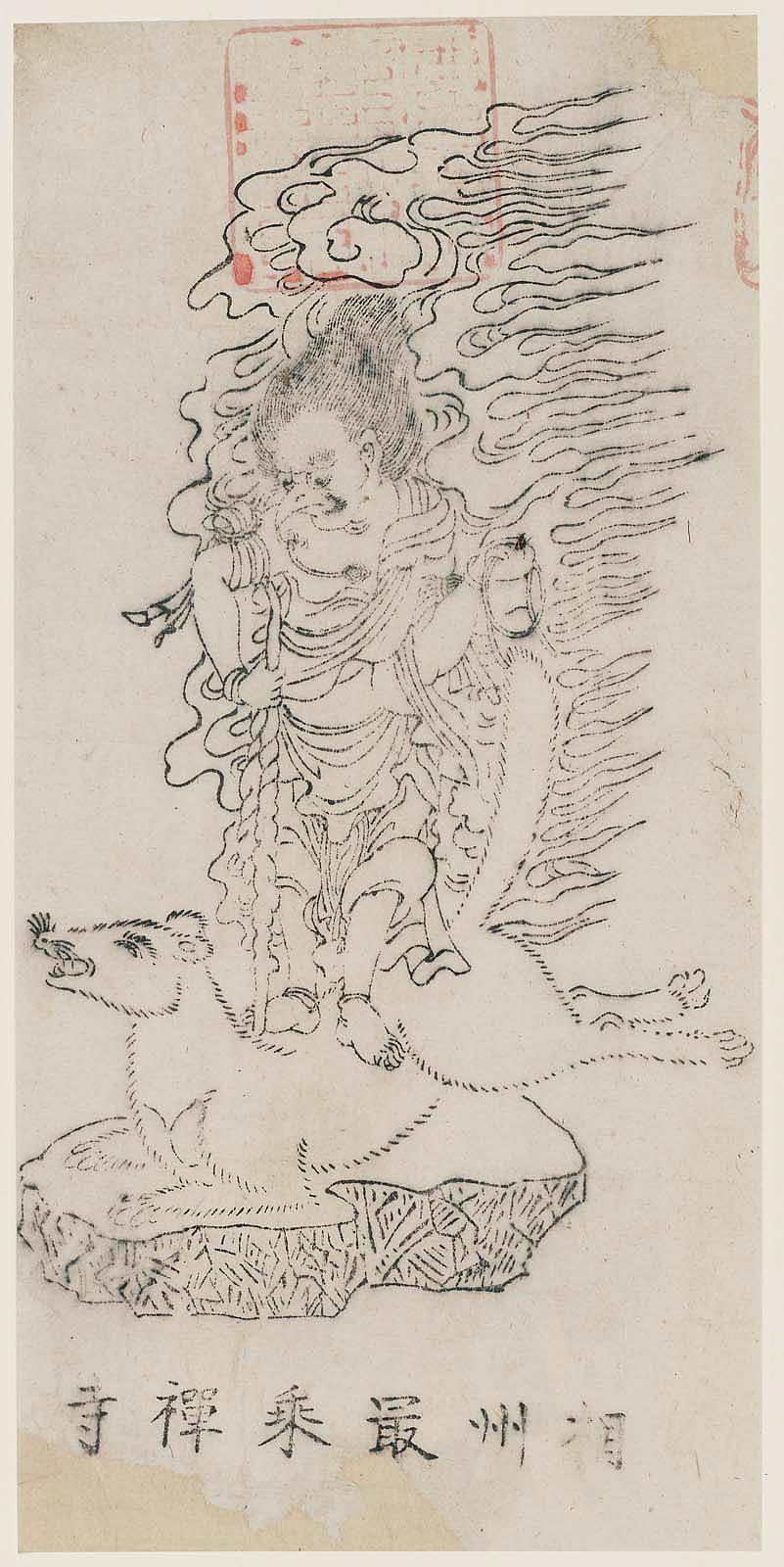
Iizuna Gongen riding on the back of a fox (Museum of Fine Arts Boston; link to the source is temporarily dead, the image is reproduced here for educational purposes only)
The indisputable center of the network of connections between foxes and tengu is Iizuna Gongen (飯綱権現), depicted as a tengu riding on a fox. As you can probably guess, he was a (vague) basis for Megumu, as evidenced by the similarity of the names. While many other aspects of his character aren’t really touched upon in the game, I’d hazard a guess he’s also the reason why ZUN decided to include a kuda-gitsune in the same game as Megumu - the evidence lines up exceptionally well, as you’ll see.
Originally Iizuna Gongen was simply the deity of Mount Iizuna (飯綱山), located in the modern Nagano prefecture. Near the end of the Japanese middle ages he spread to other areas, likely thanks to traveling shugenja (also known as yamabushi), mountain ascetics belonging to a religious tradition known as Shugendō. Two aspects of his character are particularly pronounced, his role as a martial deity and his association with foxes.
I was unable to determine when Iizuna Gongen’s connection to foxes originally developed, but it was strong enough to lead to the use of the alternate name Chira Tenko (智羅天狐; “Chira the heavenly fox”) to refer to him. Foxes also appear in a legend describing his origin. It states that he was one of the eighteen children of an Indian king, and arrived in Japan alongside nine of his siblings on the back of a white fox during the reign of emperor Kinmei (the remaining eight went to China and became monks on Mount Tiantai).
His connection to foxes is also reaffirmed in an Edo period treatise, Reflections on Inari Shrine (稲荷神社考, Inari jinja kō), which declares that names such as Iizuna Gongen and Matarajin (sic!) are used in the worship of wild foxes to hide the true nature of the invoked entities. The author further states that the true form of “these matarajin (plural) and wild foxes” is that of a three-faced and six-armed deity, which curiously has more to do with early Matarajin tradition than with Iizuna Gongen as far as I can tell. The two were not really closely associated otherwise, but it’s worth noting that apparently shugenja perceived them both as similar tengu-like deities.
The key feature of conventional iconography of Iizuna Gongen, the fox mount, has nothing to do with Matarajin strictly speaking, and likely reflects the influence of Dakiniten. However, the animal in this context developed its own unique identity thanks to the presence of foxes in a type of ritual focused on Iizuna Gongen, which could itself be referred to as iizuna. The shugenja community centered on the worship of Iizuna Gongen was not very formalized, which led to poor understanding of their practice among outsiders, with the term iizuna basically acquiring the vague meaning along the lines of “magic”. and rather poor reputation. These rites are where the kuda-gitsune comes into play.
Kuda-gitsune in iizuna magic and beyond

The kuda-gitsune, as depicted in Shōzan Chomon Kishū by Miyoshi Shōzan (Waseda University History Museum; reproduced here for educational purposes only)
At first glance, kuda-gitsune is just one of many local variants of the standard supernatural fox, similarly to the likes of ninko, osaki-gitsune or nogitsune. The etymology of its name is straightforward. I’m sure you can guess what the second half means, while kuda (管) in this context refers to a bamboo tube. You’d think the name would basically guarantee it was universally accepted that’s how one could carry such a critter undetected, but apparently there was an alternate explanation, namely that it was invisible. I have not seen any further discussion of this in literature, but I assume this might be connected to shikigami beliefs, as these quite often are described as invisible. Do not quote me on that, though. Even more bizarrely, there is no consensus that the animal meant was always a fox. According to Bernard Faure it is distinctly possible the term referred to a weasel.
Kuda-gitsune could be described as a type of shikigami, but note that this term had a much broader meaning in real life than in Touhou, and referred to basically any supernatural being which acted as an extension of the powers attributed to “ritual specialists” (祈祷師) such as onmyōji, shugenja or Buddhist monks. In Buddhist context, the analogous term could be gohō dōji (護法童子; “Dharma-protecting lads”), though there are also cases where gohō and shikigami are contrasted with each other. The shikigami category didn’t just consist of animated papercraft and animal spirits typically designated as such in popculture. Even the twelve heavenly generals defending the “medicine Buddha” Yakushi could be labeled as shikigami. Obviously, kuda-gitsune is closer to the familiar meaning of this term than to Buddhist deities, though.
People relying on kuda-gitsune were referred to as kitsune-tsukai (狐使い), which can be loosely translated as “fox tamer”, and it is said they were often shugenja. Given the popularity of the associated deity among them this shouldn’t really be a surprise.
Various supernatural abilities were ascribed to the kuda-gitsune. The ability to possess people attributed to other supernatural foxes was the domain of kuda-gitsune too. Apparently people afflicted by it were compelled to eat nothing but raw miso. Purportedly they were bringers of wealth - but said wealth did not necessarily come from legitimate sources. That, in turn, could lead to distrust or outright ostracism of people allegedly relying on foxes to acquire wealth. They also provided aid in divination, and could supposedly reveal past, present and future alike this way. However, they could look into the soul of anyone using them this way and learn their secrets. Bernard Faure notes that occasionally it was said that they even could even be utilized to kill enemies who attempted casting spells on their owner.
Shigeru Mizuki's kuda-gitsune
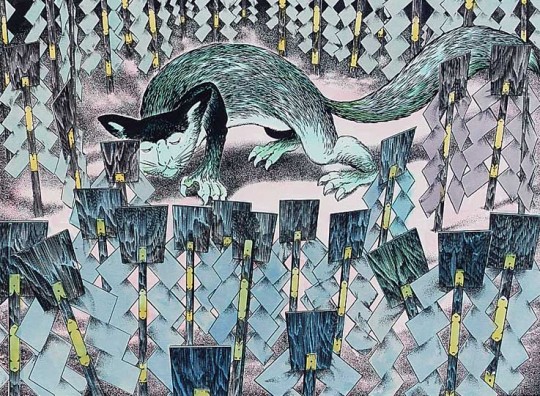
Kuda-gitsune, as depicted by Shigeru Mizuki (reproduced here for educational purposes only)
While there isn’t much information about kuda-gitsune in scholarship, especially scholarship available online in English, they received extensive coverage in various books about youkai written by Shigeru Mizuki, famous for arguably canonizing the modern concept of youkai. Note that while I am a fan of Mizuki's works, his encyclopedias are best understood as something closer to Borges’ Book of Imaginary Beings, complete with some dubious sourcing and possible fabrications. However, ultimately modern media about youkai, including Touhou, owes much to him, and arguably he continued the tradition of night parade scrolls which often invented new creatures wholesale, so it strikes me as entirely fair game to summarize what he has to say too.
Shigeru Mizuki cited the Edo period writer Matsura Seizan as an authority on kuda-gitsune. He states ccording to the latter, certain ascetics (yamabushi) were provided with these critters upon finishing their training on Mount Kinpu and Mount Ōmine. In his account cited by Mizuki there are a lot of details I haven’t seen elsewhere. The storage tubes after which kuda-gitsune are named apparently had to be inscribed with a certain sanskrit phrase (left unspecified, tragically) so that the animals didn’t have to be fed. However, releasing them and giving it food was necessary to gain their help in divination. There was a downside to this - kuda-gitsune were apparently hard to place back in containment once released without the help of a seasoned specialist. Also, they refused to provide anything of value unless fed well, and they had quite the appetite. Mizuki cites the particularly disastrous case of an ascetic who kept multiple kuda-gitsune in a single tube, and eventually couldn’t pay for enough food for his collection since the animals kept multiplying inside.
According to Mizuki it was believed that a kuda-gitsune could be gifted by its owner to another person, but the creature would come back if it was not satisfied with the food provided by the latter. If the original “fox tamer” dies before passing their kuda-gitsune to someone else, it will instead go to the Ōji Inari shrine located in what is now the the Kita ward of Tokyo.
Conclusion: Tsukasa and her forerunners
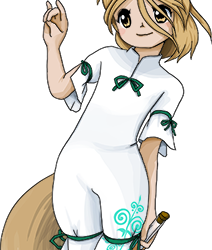
In theory I could’ve kept pointing out “see, it’s just like Tsukasa!” in virtually every single paragraph of this article. To answer the question from the title, evidently she is like that because that's how foxes have been in folklore both Japan and China for centuries.
It is not really hard to see that ZUN is genuinely great at research when he wants to be, and Tsukasa's character is remarkably accurate to her real life forerunners, both as an adaptation of kuda-gitsune specifically and as a representation of the broader tradition which lead to the portrayal of foxes as supernatural creatures of questionable moral character. She engages in morally dubious “get rich quick schemes”, she definitely provides advice (of variable quality), and her self-declared ability from her omake bio pretty clearly reflects skills actually ascribed to the kuda-gitsune in folklore. In the newest game the ability to provide information is clearly in the spotlight - Tsukasa seems to be reasonably knowledgeable (she brings up Kojiki in a line aimed at Hisami, among other things), and other characters generally agree she’d be more useful doing something else than fighting. I do not think there’s any real reason to doubt this is what is meant. I think it can even be safely assumed that Zanmu’s decision to pressure Tsukasa to partake in her assassination bluff is rooted in genuine tradition.
I’m obviously not going to say that Tsukasa reaches the platonic ideal of Okina, the quintessential character aimed at fans who like research, who largely seems to exist to get people to dig deeper for sources explaining the dozens of religious allusions in her dialogue, spell cards and design, but I do think it’s worth appreciating that the series reached a stage where even the minor animal youkai can be enjoyed as multilayered representation of centuries worth of genuine folklore and mythology.
Bibliography
-Bernard Faure, Gods of Medieval Japan vol. 1-3
-Michael Daniel Foster, The Book of Yokai. Mysterious Creatures of Japanese Folklore
-Berthe Jansen and Nobumi Iyanaga, Dākini (Brill’s Encyclopedia of Buddhism)
-Xiaofei Kang, The Cult of the Fox: Power, Gender, and Popular Religion in Late Imperial and Modern China
-Shigeru Mizuki’s assorted writings on kuda-gitsune (collected online here)
351 notes
·
View notes
Text
Deep dives into folklore: Japanese mythology

Japanese mythology is a rich and intricate tapestry woven over centuries, blending indigenous beliefs with influences from China, Korea, and beyond. The mythology of Japan is deeply rooted in Shinto, the native religion, as well as Buddhism and Confucianism. It comprises a diverse array of gods, spirits, mythical creatures, and epic tales. Let's delve into some key aspects of Japanese mythology:
Shinto and Kami:
Shinto: Shinto, meaning "the way of the gods," is the indigenous spirituality of Japan. It emphasizes the belief in kami, which can be translated as gods, spirits, or sacred forces. Shinto doesn't have a central religious text but is closely tied to rituals, ceremonies, and the reverence of nature.
Kami: Kami are considered divine beings or spirits that inhabit all things in nature. This includes rocks, trees, rivers, animals, and even human ancestors. Some prominent kami include Amaterasu, the sun goddess and ancestor of the imperial family, and Susanoo, the storm god.
Creation Myths:
Izanagi and Izanami: One of the most famous myths involves Izanagi and Izanami, the divine couple tasked with creating the Japanese archipelago and its many gods. Their union gave birth to several islands and deities, but tragedy struck when Izanami died while giving birth to the fire god Kagutsuchi.
Amaterasu's Hidden Sun: After a feud with her brother Susanoo, Amaterasu, the sun goddess, withdrew to a cave, plunging the world into darkness. The gods tricked her into emerging, bringing light back to the world. This myth explains the cyclical nature of day and night.
Japanese Pantheon:
Amaterasu: Often considered the most important deity, Amaterasu is the goddess of the sun, symbolizing light, fertility, and imperial power. The emperor is believed to be a direct descendant of Amaterasu.
Susanoo: The storm god, Susanoo, is associated with the sea and the destructive forces of nature. Despite his turbulent nature, he plays a crucial role in defeating the eight-headed serpent, Yamata no Orochi.
Tsukuyomi: The moon god, Tsukuyomi, is Amaterasu's brother. Unlike his stormy sibling, Tsukuyomi is associated with calmness and serenity.
Inari: A popular kami associated with rice, fertility, and prosperity. Inari is often depicted as both male and female, reflecting a duality in their nature.
Mythical Creatures:
Tengu: Human-bird hybrids known for their martial prowess and supernatural abilities. They are sometimes considered protectors of the mountains and forests.
Kappa: Water creatures resembling humanoid turtles. Kappa are mischievous but have a strong sense of politeness, and bowing to them may cause them to spill the water contained in a depression on their heads, rendering them powerless.
Yokai: A broad category of supernatural creatures, including spirits, demons, and monsters. Examples include the kitsune (fox spirits), oni (demons), and yurei (ghosts).
Influences on Art and Culture:
Japanese mythology has left an indelible mark on various aspects of Japanese culture, from traditional arts like Noh and Kabuki theater to literature, visual arts, and contemporary popular culture, as seen in anime and manga.
In summary, Japanese mythology is a captivating blend of creation stories, divine beings, and mythical creatures that provide a rich cultural and spiritual foundation for the people of Japan. It continues to inspire and shape the country's identity, connecting the past with the present.
#deep dives into folklore#folklore#deep dives#japanese mythology#mythology#japanese myths#legends#writeblr#writers of tumblr#writing#bookish#booklr#fantasy books#creative writing#book blog#ya fantasy books#ya books
43 notes
·
View notes
Text
Hey lovely Tumblrs! I'm planning to launch my self-published book "Greek Gods and Heroes" kickstarter in OCTOBER. Woohoo!!
❤️🤟😁🏛⚱️
This is a really pivotal point in my life and for my book project. After almost 2 years of debating whether to self-publish or to attempt traditional publishing (getting an agent and pitching to publishing houses), ive decided to self-publish and do the crowdfunding for the publishing through kickstarter. There's a few reasons why i am choosing to self-publish. The main reason is that it could take a couple years from querying agents, to pitching to publishing houses, to editing, and finally getting the book on store shelves through traditional publishing.
I'd prefer to get the book out to everyone in 6-8 months and already be rocking and rolling onto the next book by early next year if possible. my ultimate goal is to do a new book each year and self publish at year's end. I've got a bunch of cool topics for future books: trojan war cycle, Shakespeare, norse myths, overview of Masterpieces of world literature, King arthur, japanese literature,myths, and ghost stories, and many more
So as of now, i will be planning to launch my kickstarter in October, then use the end of the year for final art, edits, and polish, and ship out early 2024. This will be my first kickstarter, and Id love to hear from folks if you have any advice or tips. It would mean the world to me if you can help spread the word in the next three months with your followers.
This is going to be a super fun thing to bring into the world and a dream come true. I literally can't do this without you all, so, needless to say, I'm crazy grateful for everyone's interest and support! You all are the best! Wish me luck on this next stage! xoxo
#pagan#hellenism#greek mythology#tagamemnon#mythology tag#percyjackson#dark academia#greek#greekmyths#classical literature#percy jackon and the olympians#pjo#homer#iliad#classics#mythologyart#art#artists on tumblr#odyssey#literature#ancientworld#ancienthistory#ancient civilizations#ancientgreece#olympians#greekgods#zeus#hesiod
55 notes
·
View notes
Text
Analyzing the manga panels where Kenshin dreams of Tomoe after leaving Rakuninmura
These five pages hold a profound place in my heart, a beautiful testimony of the depths of love found in literature. To discover such emotional depth in a Shounen manga was beyond my expectations.
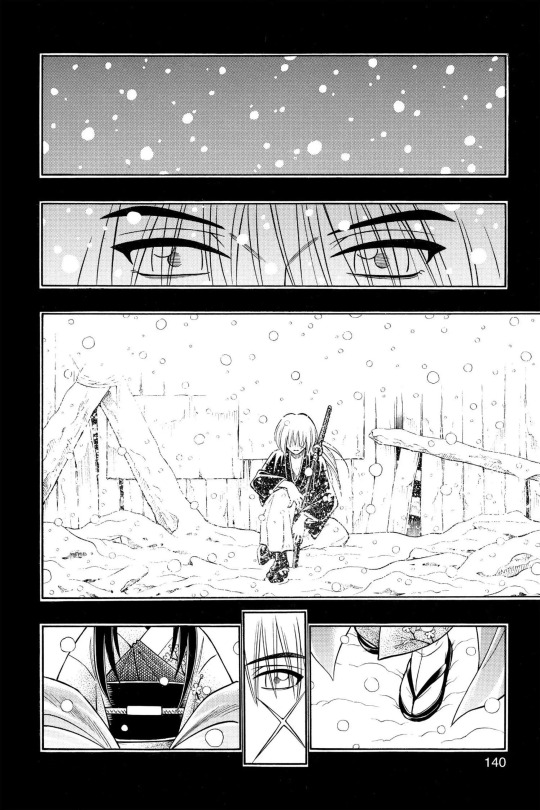

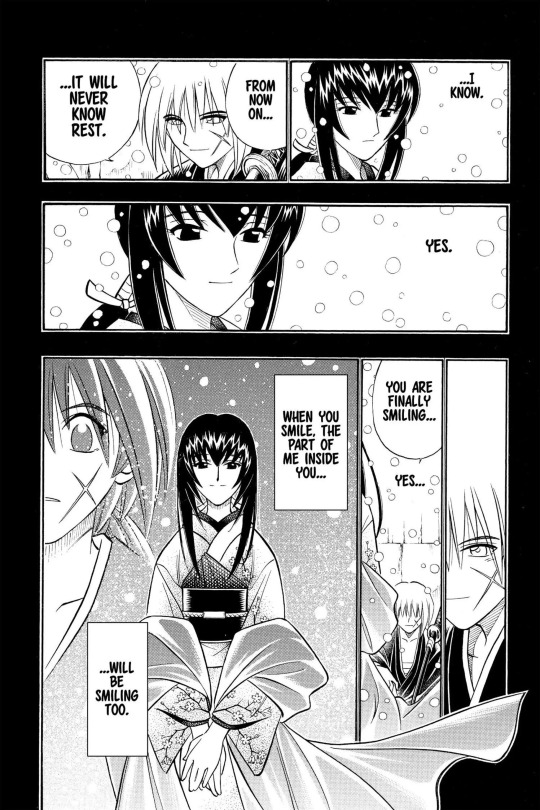
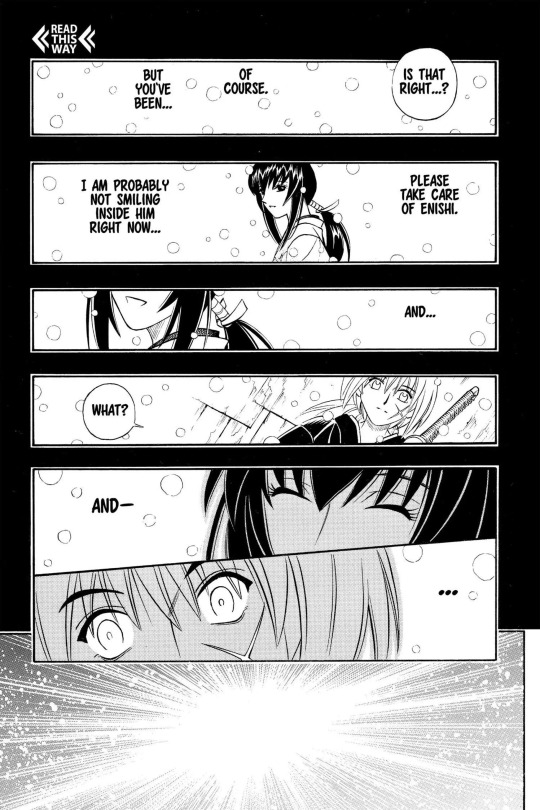

The scene unfolds with Kenshin gazing upon a familiar scenery. Yet, his eyes remain devoid of emotion, perhaps because this scenery has replayed within his mind countless times. In this moment, he believes Kaoru to be dead, he failed to protect her, her death is the grim result of revenge stemming from an accidental act - the death of Tomoe. He is uncertain if this vengeance aligns with Tomoe's wishes, for time has separated them for 15 years already. The home and love he found after 15 years of grieving for his late wife lie in ruins. His mind and soul are destroyed, and his eyelids weigh heavily, yet he gazes at the familiar scene before him.
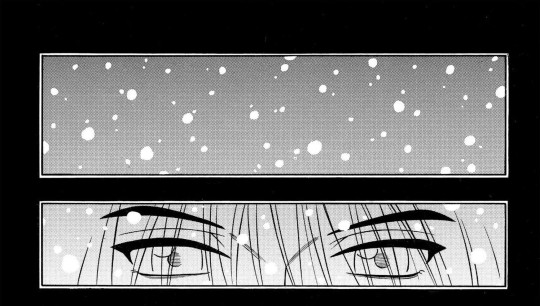
He knows what to expect as he recognizes the sound of familiar footsteps and the hem of the familiar kimono.

He soon gazes upon that familiar face, fully aware it's but an illusion, for she cannot exist in reality. Still, he continues to look at her. He refrains from speaking to her, perhaps believing she won't reply, a notion he's perhaps tested in the past.

It's truly heart-wrenching. Imagine someone incredibly dear to you, now long gone. You see an illusion, a ghost of that person, and you understand that no matter how much you call out, they'll never return. What will you do?
But this time, she speaks, and his eyes light up. He smiles, responds, and simply gazes at her as if that's all he ever needed.

I used to be genuinely puzzled by this. Many readers interpret Kenshin's emotions toward Tomoe as guilt, and I admit, I once shared that view. However, this chapter altered my perspective.
Yet, the right words to describe Kenshin's expression in these panels always eluded me. I eventually realized it might be because I had the entire backstory in my head. I had a hunch that an unrelated third party, someone unfamiliar with the story, might grasp it better. So, I shared these two panels with my artist mother, a 65-year-old who's never read manga or watched anime. Her observations were fascinating and truly eye-opening.

Regarding the panel above, I posed these questions to her:
"What emotions do you believe these two characters are experiencing?"
In response, my mother conveyed her thoughts on Tomoe, stating, "She appears to be showing concern."
As for Kenshin, her perspective was "A mix of surprise and sadness."
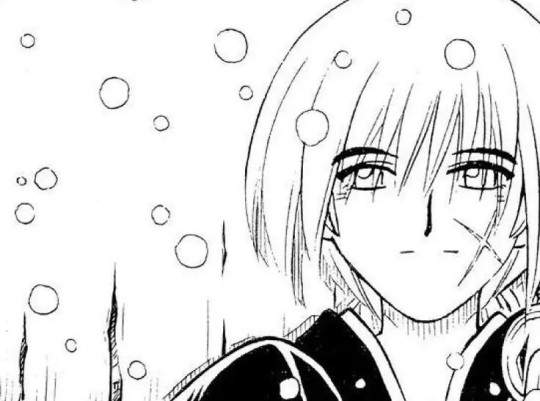
I went a step further and shared the image above with her because I've always found it challenging to discern his emotions. I believed that my mother, who is not only an artist but also a deeply empathetic individual, might be able to grasp his feelings.
Her response, after translation, was as follows:
"He appears to be gazing at something, and whatever he sees, he feels..."
She paused for a moment.
I asked her, "Do you think he feels happy?"
She replied, "No. I don't believe it's happiness; there's no sense of excitement."
She continued, struggling to find the right word, "It's more like...whatever he's witnessing... it's what he yearned to see. Like, this is it."
Finally, she found the word. Being of Indian descent, she used the term "Prashanti (प्रशांति)."
In my mind, everything fell into place. It was the word I had been searching for. "Prashanti" translates to "peace," but "peace" translates to "Shanti (शांति)." Prashanti, however, signifies "supreme peace." His expression seems to convey a sense of completeness.
In the next panels, he begins to talk about his conviction but averts her gaze. I found myself curious about this, but after reading the Japanese scanlations, it all became clear. Regrettably, I don't have all the pages to share here.
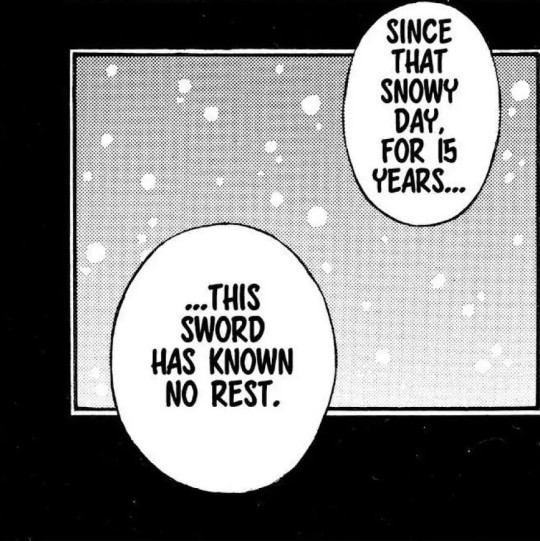
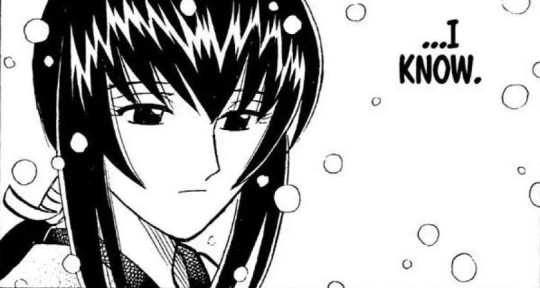
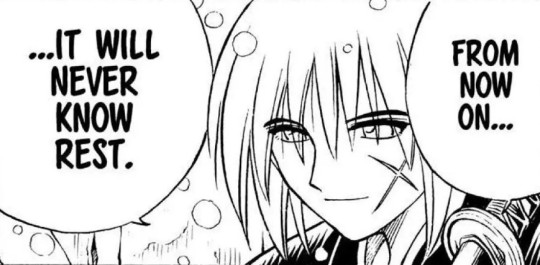
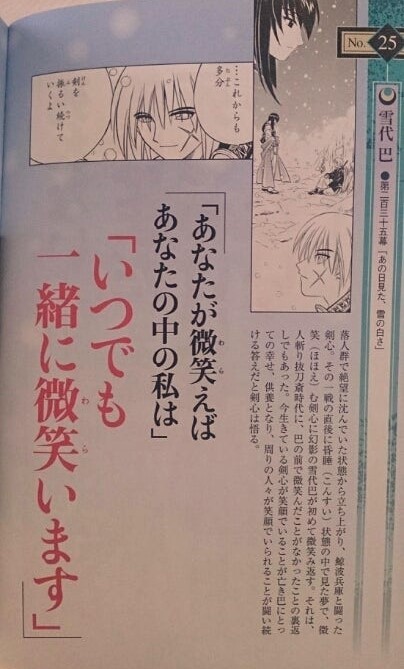
Instead of using "これからも" (which means "From now on"), he opts for "これからも…多分…" (which means "From now on... probably..."). He concludes all his sentences with "するよ" rather than just "する." This may seem subtle, but it carries significant weight because he's indirectly seeking her agreement. It's akin to the distinction between saying, "I will do it," and "You know, I will do it." Although both convey the same action, the latter grants the listener a greater say in the decision. In the context of Japanese, this difference is even more pronounced. It leads me to believe that, at this point, his promise isn't entirely set in stone.
In the next panel, Tomoe wears a serene smile and calmly responds, "Yes," as if she was aware of it from the start.

In the next panel, The translation reads "You are finally smiling." However, in the Japanese scanlations, it becomes apparent that he says "やっと笑ってくれた," which means "You are finally smiling for me."
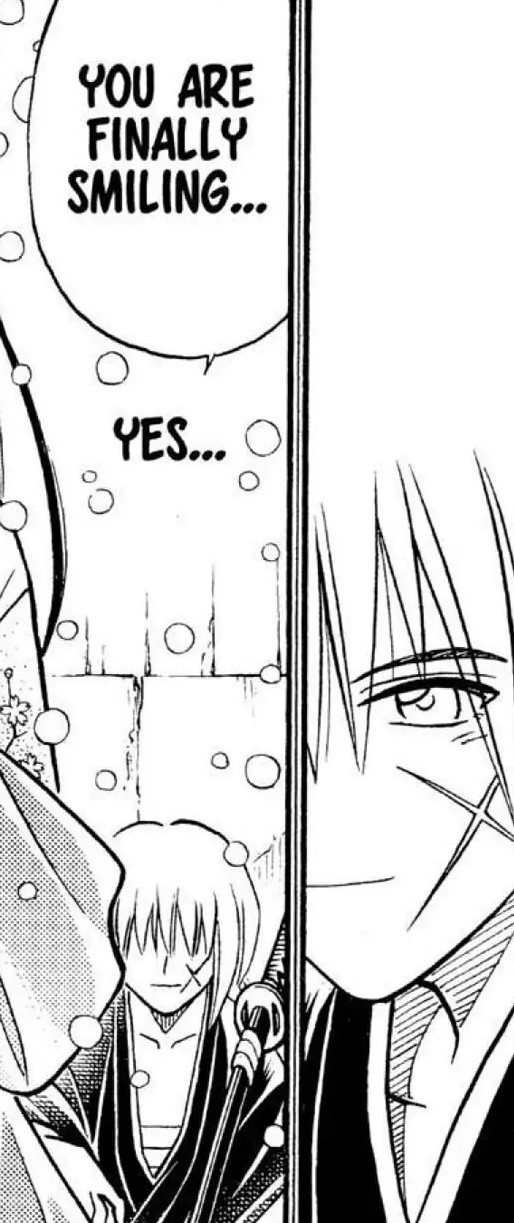
In the next panel, Tomoe tells him, "If you smile, the me inside you will always smile with you." We witness Kenshin's expression, a look of utter astonishment as if he had never fathomed such a notion, not even in his wildest dreams.

But this single panel reveals a world of emotion. It shows that Kenshin had never dared to imagine that Tomoe could feel that way for him. It also suggests that when Kenshin smiles during their conversation, it might just be the first genuine smile he's worn in 15 years because Tomoe mentions she smiles when Kenshin smiles, yet until then, she had never worn that smile.
To me, this reveals a lot about Tomoe's character. She doesn't possess the same kind of strength that Misao and Kaoru do, the strength to relentlessly pursue their love and hold onto it.
Yet, Tomoe imparts a profound lesson that we should all learn — the art of letting go.
She didn't prevent Kiyosato from leaving for Mimawarigumi. She didn't stop Kenshin from taking lives during his time as Ishin Shishi, despite it contradicting her own beliefs. Instead, she questioned him and let him make his own choices. As she approached her final moments, with her remaining strength, she wiped Kenshin's tears and consoled him, assuring him that everything was as it should be.
Nevertheless, she possessed the strength to be a mother figure and a caring sister to her brother, she had the courage to calmly stand in the presence of a killer, to watch, and to condemn the crime rather than the criminal.
Ultimately, she encouraged him to rise and go to the one who yearns most to see his smile — Kaoru.
It's beautiful because these pages reveal that to Kenshin, Tomoe's smile meant the world. Being with her was all he ever wanted; he never wanted to be apart from her. His love for her was very deep. That's why, hearing her voice, talking to her, and seeing her smile, even though none of it was real, brought him peace, even in the darkest moments, because it was what he truly desired.
Yet, whether we call it fate or a profound backstory to add depth to his character, it's what he lost.
#kenshin x tomoe#rurouni kenshin#samurai x#himura kenshin#himura tomoe#yukishiro tomoe#るろうに剣心#love#lovers#loss#character analysis
33 notes
·
View notes
Text
If you love THE ACOLYTE you should read RONIN A VISIONS NOVEL by Emma Mieko Candon
The Jedi are the most loyal servants of the Empire.
You've probably seen a lot of stuff around the Acolyte about getting into the High Republic if you want more of the same. And while the High Republic is amazing and you should read it, beyond the in-universe worldbuilding connects and that they're both stories with a lot of Jedi, they're honestly not that similar when it comes to tone and theme. If what you like the most is the unique perspective The Acolyte is bringing to the franchise, you can find more of that in Ronin.
Ronin is an expansion of the season 1 Visions short The Duel. It proposes a much more interesting origin of the Sith than what is in Legends, where you have Jedi with the samurai influence turned up to max and they are the enforcers of a corrupt state and exploiters of the peasantry. There is no Light or Dark Side. And the Sith rise up against the exploitation of non-noble force sensitive Jedi, but in the end they're fighting for their own freedom including at the expense of others. Whether you identify as pro Jedi or not, seeing what the Jedi would be like if they were actually what their worst critics- both in and out of universe- claim is a great way to expand your perspective. It draws even more on jidaigeki and Japanese mythology in general. The writing style is very unique, invoking barely localized Japanese literature.
Two decades ago, Jedi clans clashed in service to feuding lords. Sickened by this endless cycle, a sect of Jedi rebelled, seeking to control their own destiny and claim power in service of no master. They called themselves Sith.
The Sith rebellion failed, succumbing to infighting and betrayal, and the once rival lords unified to create an Empire . . . but even an Empire at peace is not free from violence.
Far on the edge of the Outer Rim, one former Sith wanders, accompanied only by a faithful droid and the ghost of a less civilized age. He carries a lightsaber, but claims lineage to no Jedi clan, and pledges allegiance to no lord. Little is known about him, including his name, for he never speaks of his past, nor his regrets. His history is as guarded as the red blade of destruction he carries sheathed at his side.
As the galaxy’s perpetual cycle of violence continues to interrupt his self-imposed exile, and he is forced to duel an enigmatic bandit claiming the title of Sith, it becomes clear that no amount of wandering will ever let him outpace the specters of his former life.
As for the similarities to the Acolyte, you got a darker tone, mystery, learning the backstory of characters as you go, a new way of seeing the Force, and witch(es).
It's also extremely queer. The main character in pansexual. One member of the main cast, the mysterious Traveler, is non-binary. There's also a sapphic romantic subplot.
It follows the Ronin right after the events of the Duel, where he is forced to join the Traveler, Chie- a bounty hunter who hunts Jedi while believing in her own Force religion, and Ekiya- a member of a people who the Sith displaced and forced to fight for them, now trying to regain her people's homeland. You also get to learn what the Sith Bandit's deal is.
It is in its own continuity (although it has also had some one-shot comics also telling original stories), although in my personal version of Star Wars it is a mythohistory about the ancient history of the Jedi and Sith. This means I don't have to stress out about the specifies of technology and magic, but can use the general gist to create my own narrative in my head.
7 notes
·
View notes
Note
(marked ourselves as a non cuz wanna stay anonymous)
Names: any ddlc or dark academia names! Satori, Ruru, and sayori r ones to be included pls
Age: minor / highschool
Pronouns (specify if you want 1st, 2nd, or 3rd person pronouns; 3rd person pronouns are default if you don't specify): all / any, puppy related pronouns, kitten related prns, plush related prns, literature related prns (cuz ddlc, yk yk), femboy & nonbinary prns, dark academia prns
Titles: anything dark academia or literature!
Genders: femboyish genders, nonbinary genders, pup / kit related genders, sui / sh related genders, ghost genders, angel) deity related, undead related
Orientations: lesboy, loserboyic, etc and love loser, yandere, puppy, ghost related, sui/sh related prns, ddlc related prns/sayori related prns, angel prn, undead prns!
TransIDs: trans Japanese, trans winged, add anymore u think would fit!! (ddlc, dark academia and puppy/kitty n angel ones pls!)
Non/Alterhumanity: sure!!
Source: doki doki literature club
Roles: any
Origin: dunno, u pick idk wut mean sorry!!
Picrew? Y/N; if you want one feel free to send in a Picrew you want specifically— no but could u find really nice shared sayori fanart 4 pfp? Tysm!!
Banner and/or color hex? Y/N; Plurakit is in mind for this, can be for anything however. — banner with a dark academia look/background pls!! Lots of (nice) warm browns or maybe pinks (match w ddlc theme!!)
Thank u if u except this!!!
Names: Satori, Ruru, Sayori, Riyuka, Ambrose, Bellamy, Ariadne
Age: 17
Pronouns: All/any, Pup/pups, Whine/whines, Book/books, Kit/kits, Soft/softs, Purr/purrs, Hang/hangs, Cut/cuts, Shi/hir, Love/lover, Heart/beat/hearts/beats, Blade/blades, Dead/deads
Titles: One who Reads, BookWorm in Love, Storyteller, PRN who's invested in PRN's stories
Genders: Gxrl, Girlboy, Ghostgender, Deadgirl, Loverboy, Feminine Xeno, Paraminflux, Suicidefluid, Booklexic, 2010scoric, Alliumian, Amareale, Altsoftpupboy, Angelibian
Orientations: Lesboy, Loserboyic, Love Loser
TransIDs: TransSelfAware, TransWinged, TransJapanese, TransLolita, TransGlasses, TransAngel, ForcedTransDead, TransSHScars, CisLonely, Suicidalflux, TransMeow, TransPurr, Transpet, Permapet, Transintersex
Non/Alterhumanity: Game NPC/Character
Source: Doki Doki Literature Club
Roles: Intrusive Thoughts Holder, XenoRole, Silencer, Persecutor
Origin: Altpackgenic, Willogenic
FaceClaim:

Couldn't find the artist :( but this is all I deemed ok enough because I have high standards for these requests ^^"
Banner:

#☢️#📄#alter packs#build a alter#pro rq 🌈🍓#pro 🍓🌈#radqueer#bah blog#build a headmate#pro radq#rq 🌈🍓#rq community
10 notes
·
View notes
Text
Sailor Regulus
╔═════ ∘◦⛧ミ◦∘ ══════╗
Seishin Wantanabe / Sailor Regulus
╚═════ ∘◦ ミ⛧ ◦∘ ═════╝

:Mission:
Seishin was just an ordinary kid going to Mugan Academy. She’s trying to get to grips with highschool bullies, algebra and how to wear a skirt when suddenly a mysterious force wants her dead.
Turns out she’s Sailor Regulus, reincarnation of a warrior princess and last of the Leo’s Alliance. Fortunately she has the Inners to teach her, and she’ll need all the help she can get. Her forefathers protected the mysterious Infinite Lion Armor but one by one they were struck down by the brutal legionnaire Alcides, and he will not let some puny princess stand between him and immortality.

╔═══*.·:·.☽✧ ✦ ✧☾.·:·.*═══╗
Civilian Form
╚═══*.·:·.☽✧ ✦ ✧☾.·:·.*═══╝
:Name & Meaning:
Although he was born with the name Yurei, meaning ‘ghost’, it began to fit less and less until highschool was a chance to reinvent herself. She chose the name Seishin, a feminine name meaning ‘spirit’. Her surname Wantanabe means ‘transition’ or ‘to cross’ .
:Age & Birthday:
Born on the 2nd of August, she’s fifteen and a Leo.
:Appearance:
Seishin stands quite tall for her age at 5’6 with a lanky figure she tries to hide behind various fashions. She’s always felt more comfortable with long hair, letting it fall in a silky veil to her waist with a brushed fringe and two long ribbons framing her face. Her eyes are a sapphire blue and her skin is slightly tanned with a long scar running down her right shoulder blade, red and raised and of unknown origin.
Although she’s still exploring her tastes, Seishin chooses cute and spunky fashion. She loves to accessorise with gloves and belts and colourful kerchiefs! Her jewellery box is filled with necklaces and dangling earrings. She is especially drawn to glittering, cut stones which she brings out at every chance.
:Nationality

It means that although she’s practically an adult she has to relearn everything. She’s nearly fluent in the language but her knowledge of manners and customs still requires polish.
:Personality:
On top of transitioning to a female, moving to a new country and joining a new school, Seishin learns she’s a star princess sworn to fight evil. All these alien experiences have made her desperate to fit in and somewhat gullible, but it also makes her much more empathetic to the adversity of others. Her loyalty to those who support her is unwavering and her trust in them unshakable. She’s sensitive, easily distracted and her sensitivity to the opinions of others means she may suddenly need space and quiet to reassure herself.
This need to please makes Regulus a strong fighter and she doesn’t want to let her new teammates down. She idolises Sailor Moon and Sailor Venus as protectors both strong and feminine. She wants to impress them but as an amateur senshi she's still learning the tricks of the trade and harnessing her own growing powers. When she gets too excited her powers are prone to friendly fire which is so embarrassing! She wants them to know that she can protect them too and be a guardian senshi in her own right so she’ll try to track down her crown on her own.
:Likes:
English essays, Fridays, winter, thunderstorms, fish and chips and apple juice.
:Dislikes:
Snakes and spiders. She once had a bad experience with a huntsman and never forgot it.
:School:
Seishin is in the tenth grade of Mugan Academy because of her father’s connections. She has inherited his love of computers, but her favourite class is Japanese where she can explore the poetry and literature of her new home. She also appreciates history as she finds the stories useful for her writing. She’s also very athletic and was recruited for Mugan’s basketball team and slam dunks like a pro.
:Hobbies:
Since transitioning she’s been developing her own look. She loves thrifting and trying new styles, from retro to loli to visual kei! Every day and every shop is filled with possibilities! She enjoys escapism, whether it is through her videogames or her creative writing. She loves to disappear inside her own worlds of magic and aliens and alternate dimensions. Little did she know she’d get first hand experience.
:Family:
Seishin’s family has always been open and understanding, so the decision to come out was welcomed with her parent’s support.
Her father Makuri (to do something too much) Wantanabe is an exceptional computer programmer and businessman but also loving and supportive of his family. He thought nothing of following his wife Callwen- who took the name Hinaki (bright) when she immigrated back to her Tokyo. She is kind and accepting and has tried to pass on these virtues to her two daughters.
Unfortunately it hasn’t worked. Seishin’s older sister Akuru (black jewel) resents leaving London. Despite her innocent face she has become cruel, taking her frustrations out on Seishin in violent and vindictive ways.
:Relationships:
:Akira Saito:
Akira is a girl that enjoys singing and drawing and has a challenging history with personal demons, but through singing and drawing, she finds her escape from the world. For a while, they made themselves feel like all would be okay. She's also grown very fond of Seishin. The kindness she shows is very much needed, and in return, she loves having Seishin as a model for her. Yet one drawing from before she met Seishin is too eerily close to a vision she's seen.
:Chiyo Bushida:
Chiyo is a girl from a family that prides itself on honesty, integrity and hard work, coming from a family line that started from next to nothing, constantly swearing to keep remembering the values told by their great grandparents. She enjoys physical activities during the sports curriculums, especially full-contact sports that require physical strength and skill. They have grown close to each other with a friendly rivalry on the basketball court.
:Alexa Williams:
An American transfer student is also new to the school and refuses to accept the traditions compared to what she's used to in the States. She’s snobbish and thinks highly of only herself and her family. Due to this, she thinks everyone is a worm compared to her. She firmly believes in tradition and dislikes… Deviations. Seishin has become a favourite target because she knows something is off with that girl. Something is unnatural in how she carries herself and how she walks. She will expose it to the whole world and show everyone what a weirdo she truly is!
:Sexual Orientation:
Seishin is still figuring it out, finding a few guys and girls in her class that she's finding herself pulled towards, though she's rather obvious to queues and hints dropped by friends and the people she's been speaking wit. But out of all the people she's met there's a certain blunette who is clever and adorable.
╔═══*.·:·.☽✧ ✦ ✧☾.·:·.*═══╗
Sailor Regulus
╚═══*.·:·.☽✧ ✦ ✧☾.·:·.*═══╝
:Name:
Sailor Regulus
:Guardian Starseed:
She holds the starseed for the only large planetary body in the Regulus system which takes its name from its star. It is a dry planet, prone to boom and bust seasons, covered by various arid biomes and mysteriously pure wellsprings.
There are labyrinthine red sand dunes that tower and shift in cool breezes. And vast salt pans claimed by ancient bequeathed by transitory seas, landlocked places of death and hopelessness. The creatures that live there are strange, opportunistic scavengers.
Much of its population is nomadic, and palm groves sprouting from river wadis provide respite along migration routes but it is the permanent oasis that are the jewels of civilization. Lying above boundless aquifers, they grow plants like apricots, dates, figs, and olives. Their markets weave brightly woven cotton and trade lustrous opal, tanzanite, garnet, emerald and diamond.

:Realm of Influence:
Much of her powers come from her totem symbol, the lion. It represents family, courage and protection.
:Past Life:
In the depths of space, many aeons ago was King Nemea, the Lion Majesty. He was rumoured to be immortal due to his impenetrable armour and powerful weapons. He would fight the agents of Chaos, shining as a beacon of hope as golden as the sun.
He doted on his five daughters and he vowed he would always protect them. When they were married he gave each of them an heirloom to pass down through the generations. Denebola his breastplate, Subra his pauldrons, Chort his cuirass, Zosma his girdle, Algieba his greaves and Regulus his crown to unite them. Time passed and history vanished into legend.
Until one day a ferociously cruel mercenary named Alcides consulted the Oracle of Ophiuchus; The Pythoness. He yearned for immortality and she told him of the renowned armour of the Lion Majesty. He and his legionaries (Achilles, a powerful, arrogant warrior. Perseus, a brilliant strategist. Orpheus, an enchanting musician. And Aeneus, alluring beauty.) struck down each of the royal families of the Leo Alliance. With each fallen star he took their Artefact, bringing him closer to the all powerful, undying conqueror he knew was his destiny.
The King Othniel (Lion of Kings) and Queen Ariel (Lion of God) of Regulus knew of his approach and feared for their daughter. They used the Silver Millennium Cotillion as an excuse to smuggle Princess Leocadia (Splendid Brightness of the Lion) and her guard Sapphire out of the system, leaving behind her parents and sisters. There she was briefly introduced to Silver Queen Serenity, her daughter and the inner princesses who made her feel at home.
The peace was short-lived as the Moon Kingdom was struck down. Sailor Regulus was separated from the senshi and although she fought valiantly, she also lost her life. She was also reincarnated, although perhaps not as intended.
However Grand Regis Alcedes hasn’t given up. With five of the six artefacts he has only aged ten years of the one thousand , but it is ten years he will make the heir of Nemea regret. After years of searching he has finally found the key to life eternal and nothing. Will stand in his way.
:Allies/Team Mates:
Leo Senshi:
Long ago it was expected Sailor Regulus would replace her father as the guardian of Regulus when she came of age and part of that responsibility would be leading the senshi of the Leo Alliance.
In his quest for the Artefacts, it is thought that the Great King Alcedes killed them and their starseeds returned to the Galaxy Cauldron. It is unknown if they have reincarnated but likely they would be drawn to the remaining heir.
Sailor Denebola - MIA
Sailor Subra - MIA
Sailor Chort - MIA
Sailor Zosma - MIA
Sailor Algieba - MIA
Inners:
Although only a year younger than the Inners, Regulus is the baby of the senshi still finding her feet. Venus is a wonderful leader and teacher, as is Artemis. Together they patrol the night searching for leads. However she feels herself warm and flustered as she gets to know Sailor Mercury.

Spirit Guide:
When King Othniel sent his daughter to the Silver Millennium Cotillion he sent her personal guard, Captain Saphira with her. She died defending Princess Leocadia and when she was reincarnated on Earth she vowed she would never fail her again.

Captain Saphira belongs to the planet Hund, a species like the Mauese have the ability to switch between canine and human form. They are well appreciated across the galaxy for their loyalty and determination. Captain Saphira’s canine form bears a striking resemblance to Earth’s golden retrievers. Unfortunately since reincarnating she hasn’t been able to transform back into her human form.
Saphira has a sisterly protection of Seishin, and is often all that stands between her and Akura’s bullying.
Know your enemy, know your enemy and you know the key to victory. She spends a lot of time with Sailor Mercury researching Alcedes past conquests to fortify their team for the coming fight. She believes in preparation and cringes at Sailor Regulus’s rash behaviour in battle.
:Henshin Item:

Given to her in a flash of light by her bodyguard Saphira, she received the Ring of Regulus. Although she was expected to have her own transformation item forged when she came of age, there was no time. King Othniel pressed his own ring, that which transformed him into the warrior Lion Heart, into her palm as she left for the Silver Millenium.
It is a golden ring with a sapphire clenched in the jaws of a maned lion’s head. The sapphire is inscribed with the symbol of Leo. It’s a little loose but Seisen treasures it as a link to her past.
:Henshin Phrase:
Seishen reaches to the sky with her hand aloft and ring finger gleaming. She shouts "Leo! Regulus! Give me strength!"
Bright blue flames erupt from the sapphire, coalescing into the the form of a lion’s head behind her before dissolving in tongues of fire. They lick out, wrapping around her body to form her bodice and skirt. They tangle with her arms and legs to reveal her heels and gloves. Finally the head roars again, blowing her hair in turmoil and on her brow gleams her symbol before forming a teardrop shaped sapphire burning with an inner fire.
The sapphire flames whirling around her body recede back into the lion which bellows one more time as Sailor Regulus poses and prepares to attack.
:Symbol:

:Guardian Challenge:
“Arising for the fires of battle, I am the lion hearted Sailor Regulus and with pride I’ll protect! Surrender now or face my wrath!”
:Guardian Fuku:
Sailor Regulus is wilder than her civilian counterpart. Her body is distinctly feminine, with breasts and flaring hips. Her silky hair is long and unruly, an untamed mane that flies around her in battle. Her scruffy fringe hides that she doesn’t have a tiara, but a teardrop shaped sapphire between her eyes that glows and flashes as she becomes more emotional.
With white signalling calm and cool, blue signalifying feelings of sorrow, pink flustered, red overwhelming rage and black.
Her sailor colour is midnight blue with gold and white trim in a lattice edge. Her bodice is two layered, black with wite over, trimmed in gold with golden hip guards. Her skirt is also two layered, pleated white with an overlay of midnight blue, lighter and more flowing. Her blueblack gloves have metallic rings with tufted white fur. She wears white open toed sandals just over her ankles.
:Weapon:
Her ancestral weapon is the Lion Rampant, a urumi or whipsword that would lash like claws.

:Attacks:
Regulus Roaring Rush
Regulus crosses her arms across her chest before flinging them wide with a guttural scream. Behind her the majestic maned lion head lets out a deafening roar, stunning the enemy and sending them flying in furious winds.
Regulus Claw Crush
Regulus swipes her claw like fingers through the air and spectral claws maul the enemy again and again.
Regulus Lion’s Pride
Regulus stands tall, her body beginning to glow as one by one five giant phantasmic lions begin to burn with silver auras. With the final word they lunge to destroy the enemy.
⊱ ────── {.⋅ ✯ ⋅.} ────── ⊰
╔═══*.·:·.☽✧ ✦ ✧☾.·:·.*═══╗
Trivia
╚═══*.·:·.☽✧ ✦ ✧☾.·:·.*═══╝
Lei motif: Ed Sheeran - Celestial
Transformation Theme: Head Of The Table
Battle Music: Let's Light It Up

#sailormoon#sailormoonoc#otaku senshi#sailor moon oc#sailor moon#otakusenshi#sailormoon oc#fansenshialliance#leo alliance
4 notes
·
View notes
Text

.·:*¨༺ intro post ༻¨*:·.
hello, my name is mack, i live in north america, and im 16 years old. this tumblr will be about my favorite things, movies, games, tv shows, what have you, and also will store my rants for whenever i want to go on about something. if that’s what your interested in, follow me!
**•̩̩͙✩•̩̩͙*˚ interests ˚*•̩̩͙✩•̩̩͙*˚*
**•̩̩͙✩•̩̩͙*˚games: fatal frame (esp 2,3 &4), silent hill, rules of rose, parasocial, aka manto, omori, creepypasta land RPG, sanpo, resident evil (need to look more into it, though.), corpse party, kuon
**•̩̩͙✩•̩̩͙*˚movies: ringu, carved, the grudge, the craft, silence of the lambs, the conjuring movies, the amityville horror, saw, fight club, lady bird, girl interrupted
**•̩̩͙✩•̩̩͙*˚music: dido, deftones, lamp, ichiko aoba, bauhaus, siouxsie and the banshees, depeche mode, lana del rey, bôa, fleetwood mac, joy division, cigarettes after sex
**•̩̩͙✩•̩̩͙*˚misc: japanese urban legends, crochet / knitting, art, reading (mostly literature or horror), history, science, space, psychology, vintage things, old web look, old ghost stories, cats, victorian and edwardian era
* other tumblrs: @webchixx – @nichtessence





#introductory post#marcidgrrl#deftones#outer space#fatal frame#silent hill#j horror#girl blogger#sylvia plath#pyschology#victorian era#edwardian era#edwardian#ringu#girl interrupted#dido#gothic#joy division#420girl
7 notes
·
View notes
Text
Brainwaves Bios: Doctor Egon Spengler (1984)
The Brain of The Ghostbusters Doctor Egon Spengler, PhD

The brains of the Ghostbusters. He designed all the team's equipment and normally comes up with the plan to trap the ghosts. Overly analytical, Egon comes off as colder and more distant than he actually is.
"I collect spores, molds, and fungus."
Name
Full Legal Name: Egon Malachi Spengler
First Name: Egon
Meaning: From the Old German name 'Egino' derived from the element 'Agin' meaning 'Edge, Blade'
Pronunciation: EH-gawn
Origin: German
Middle Name: Malachi
Meaning: From the Hebrew name 'Mal'akhi' meaning 'My messenger' or 'My angel'
Pronunciation: MAL-a-kie
Origin: Hebrew, English, Biblical, Biblical Latin
Surname: Spengler
Meaning: Occupational surname literally meaning 'Metal worker' or 'Tin knocker'
Pronunciation: SPENG-ler
Origin: German
Titles: Doctor, Professor, Mr
Nicknames: Egie, Spengs
Characteristics
Age: 40
Gender: Male. He/Him Pronouns
Race: Human
Nationality: American Citizen. Born in America
Ethnicity: White
Birth Date: November 21st 1944
Sexuality: Aromatic, Straight
Religion: Jewish
Native Language: English
Known Languages: English, Hebrew, Spanish, Chinese, Japanese, Russian, Portuguese, Latin, Greek, Egyptian, Arabic
Relationship Status: Single
Astrological Sign: Scorpio
Actor: Harold Ramis

Geographical Characteristics
Birthplace: Cleveland, Cuyahoga County, Ohio
Current Residence: North Moore Street, New York, New York
Appearance
Height: 6'5" / 195 cm
Weight: 175 lbs / 79 kg
Eye Colour: Brown
Hair Colour: Brown
Hair Dye: None
Body Hair: Hairy
Facial Hair: Clean Shaven
Tattoos: (As of Jan 1984) None
Piercings: None
Scars: None
Health and Fitness
Allergies: None
Alcoholic, Smoker, Drug User: Clean
Illnesses/Disorders: None Diagnosed (Possibly Autistic)
Medications: None
Any Specific Diet: None
Relationships
Affiliated Groups: Ghostbusters (Founding Member)
Friends: Peter Venkman, Raymond Stantz, Winston Zeddemore, Janine Melnitz, Louis Tully (Sort-Of), Dana Barrett
Significant Other: None
Previous Partners: None of Note
Parents: Edmund Spengler (70, Father), Esther Spengler (73,Mother, Née Schneider)
Parents-In-Law: None
Siblings: Elon Spengler (40, Twin Brother)
Siblings-In-Law: Eliana Spengler (37, Elon's Wife, Née Salomon)
Nieces & Nephews: Edward Spengler (4, Nephew)
Children: None
Extras
Level of Education: Anthropology PhD, Astronomy PhD, Chemistry PhD, Engineering PhD, History PhD, Metallurgy PhD, Mycology PhD, Parapsychology PhD, Philosophy PhD, Physics PhD, Psychology PhD
Occupation: Ghostbuster
Employer: Ghostbusters
Expertise:
Genius with an Eidetic Memory
Polyglot
Physicist
Mycologist
Chemist
Historian
Parapsychologist
Anthropologist
Astronomer
Engineer
Metallurgist
Faults:
Sweet-Tooth
Perceived Lack of Emotions
Doesn't Have a Driver's License
Backstory: Egon Spengler grew up with no toys because his parents didn't believe in them. For unknown reasons, he had part of a Slinky but he straightened it. On October 29, 1969, Egon graduated from Columbia University with a degree in Psychology in the faculty of Psychobiology. On May 10, 1972, Egon graduated from New York University with a degree in Parapsychology. On June 26, 1980, Egon graduated from the Massachusetts Institute of Technology with a degree of philosophy in Nuclear Engineering. Egon was very interested in paranormal phenomenon, and worked with Raymond Stantz and Peter Venkman at Columbia University's Paranormal Studies Laboratory in Weaver Hall. He and Raymond studied paranormal literature in their spare time and were interested in theories of reincarnation. Egon developed the P.K.E. Meter to detect paranormal entities and phenomena with. Egon and Raymond were usually the first to interview case subjects, even people Peter called 'Schizos' no matter how far-fetched their stories were.
17 notes
·
View notes
Text





Discover the spine-chilling history of ghosts and the supernatural across the world in this illustrated guide.
A History of Ghosts, Spirits and the Supernatural charts the extraordinary narrative of one of the most fascinating and controversial subjects in the world, covering everything from Neolithic ancestor worship and ancient necromancy to modern-day ghost-hunting and creepypasta tales and from the Japanese onryo to the La Llorona of Latin America.
The perfect introduction to the subject, this spellbinding volume details the numerous ways in which spirits and the spirit world have been depicted in myth and religion, folklore, art, and literature.
In this ghostly novel, you will find:
Recounts of infamous tales of haunted houses and ghost ships, séances and mediumships, poltergeists, possessions, and demonic encounters.
Feature profiles for other ghostly or undead beings, such as vampires and werewolves.
The numerous reasons that ghost stories and tales of the uncanny are a common feature of cultures the world over.
A serious but reader-friendly overview of a fascinating and controversial subject that explores the supernatural across the world and throughout history.
The most holistic history of the subject available, A History of Ghosts, Spirits, and the Supernatural will shock and delight you in equal measure - whether you are a believer or a skeptic.
https://amzn.to/3XQcyy0
6 notes
·
View notes
Text

How to Survive a Horror Movie: All the Skills to Dodge the Kills (Seth Grahame-Smith)
"Every month or so, a new horror movie hits #1 at the box office no wonder there are dozens of new fright films slated for release in 2007. But if you find yourself trapped in one of these movies, there's no need to be afraid. How to Survive a Horror Movie teaches readers how to cope with every kind of horror movie obstacle, from ax-wielding psychopaths to haunted Japanese VHS tapes. Chapters include:
-How to Survive a Night of Babysitting
-How to Convince the Skeptical Local Sheriff
-How to Perform an Exorcism
-How to Tell If You've Been Dead Since the Beginning of the Movie
-How to Vanquish a Murderous Doll
Full of illustrated instructions on avoiding ghosts, serial killers, haunted cars, murderous pets, telekinetic prom queens, and countless other hazards, How to Survive a Horror Movie is essential reading for movie buffs of all ages!"
Averroës's Search (Jorge Luis Borges)
"The story very much reminds me of the domain in MAG183: Monument. "The story imagines the difficulty of Averroës, the famed Islamic philosopher and translator, in translating Aristotle's Poetics because he was not able to understand what a play was, owing to the absence of live theatrical performances from Averroës' cultural milieu, in contrast to that of ancient Greece. In the story, Averroës casually observes some children play-acting, then later hears a traveler ineptly describe an actual theatrical performance he once saw in a distant land, but still fails to understand that the tragedies and comedies of which Aristotle writes are a kind of performance art, rather than merely literature.
The process of writing the story is meant to parallel the events in the story itself; Borges writes in an afterword to the story that his attempt to understand Averroës was as doomed as Averroës's attempt to understand drama. "I felt that the work mocked me, foiled me, thwarted me. I felt that Averroës, trying to imagine what a play is without ever having suspected what a theater is, was no more absurd than I, trying to imagine Averroës yet with no more material than a few snatches from Renan, Lane, and Asín Palacios.""
#16th poll#non-affiliated#leitner tournament#poll#How to Survive a Horror Movie#All the Skills to Dodge the Kills#Seth Grahame-Smith#Averroës's Search#Jorge Luis Borges
3 notes
·
View notes
Text
Will-o'-the-Wisps and Faerie Lore
Will-o'-the-wisps are mysterious lights that have captivated people's attention throughout many cultures. People frequently associate them with faeries. Folklore sometimes attributes these spectral flames, typically observed hanging over marshes, swamps, and other moist regions, to supernatural entities, particularly faeries.
According to several traditions, will-o'-the-wisps are believed to be faeries or spirits tricking travelers. People claim that these lights mislead travelers away from well-traveled routes and onto hazardous areas like bogs or quicksand, potentially causing them to become lost or endanger themselves. These stories have a strong fairy connection, with the lights believed to be the lanterns carried by cunning or evil faeries. These faeries take immense pleasure in perplexing humans, drawing them from well-traveled paths while seeming to assist them in finding their way.

According to English tradition, will-o'-the-wisps are frequently regarded as the ghosts of the dead, particularly those who had dishonest or evil lives. These spirits, sentenced to roam the planet, manifest as ghostly lights. According to some legends, they are the spirits of stillborn or unbaptized children who were unable to find rest and manifested as floating flames. This concept aligns with the broader belief that spirits and faeries exist in a state of transition between the worlds of the living and the dead.
Although their meanings vary across cultures, will-o'-the-wisps are frequently associated with faeries or otherworldly entities. According to Scandinavian tradition, will-o'-the-wisps, also known as "irrbloss," are believed to represent the souls of avaricious treasure hunters, destined to roam the earth due to their greed. Japanese folklore uses the term "hitodama" to describe a phenomenon where the spirits of the dead manifest as fire orbs. These explanations underscore the widespread belief that ghosts or otherworldly entities are associated with the lights.
Scientific literature provides a more realistic explanation for will-o'-the-wisps. Scientists suggest that the occurrence originates from the oxidation of gases produced by biological degradation in marshy areas, such as methane, diphosphane, and phosphine. These gases have the ability to spontaneously ignite when they come into contact with oxygen, giving the appearance of flickering lights. Despite this scientific understanding, the mystical and faerie appeal of will-o'-the-wisps persists in popular culture.

Generally, people portray faeries as cunning or protectors of specific natural domains, and will-o'-the-wisps easily fit into this stereotype. It is believed that the lights defend the marshes, guiding trespassers away from their region in order to keep them safe. This fits with the larger mythology surrounding faeries, who frequently serve as the natural world's guardians by utilizing their magical prowess to maintain equilibrium in their sphere of influence.
The relationship between faeries and will-o'-the-wisps highlights the intricate web of legend that unites the natural and supernatural realms. Whether we perceive them as mischievous faeries, restless spirits, or natural phenomena, will-o'-the-wisps, representing the persistent human obsession with the mysterious and unknown, are fascinating and mystifying. Legends and folklore surrounding these lights serve as a reminder of the magic and mystery lurking in the uncharted regions of our planet, where ghosts and faeries may still play in the darkness.
4 notes
·
View notes
Text
Fantasy throughout the world
On top of having an article centered around the French fantasy specifically, the "Modern Success" issue of the BNF Fantasy series also has an article (again written by Anne Besson) covering the topic of "Fantasy throughout the world". Here is, once again, a rough translation by your humble servant:
While heavily dominated by an English-speaking production, fantasy literature found its place in numerous European countries, and managed to cross several continents.
Born in England, grown in parallel on the two sides of the Atlantic oceans, and becoming a mass-phenomenon in the United-States, fantasy is without a doubt an anglophone genre. Even today the fantasy market has a MASSIVE unbalance, and the modern fantasy successes prove that the mondialization of the imaginations is dominated by the cultural superpower of the USA. But ever since the 1970s, as the translations of Tolkien spread across the world and role-playing games conquered the heart of teenagers, "native fantasies" started to appear in various European languages.
German fantasy is a good example of one of those "local takes" - it does help that Germany has a literary background including the Romantic movement, and the brothers Grimm fairytales. After the enormous success of Michael Ende's Never-Ending Story in 1979, the German fantasy did not stop. Many successful authors appeared. Wolfgang Hohlbein gained an internal fame, with his 1982 Märchenmond or his 1999's Chronicles of the Immortals. Cornelia Funke was a famous German youth author, with her trilogy "Inkworld" in 2003. Kai Meyer reworked Germanic legends in his 1998's Loreley or his 2001's Nibelungengold. Walter Moers created the continent of Zamonia, and popularized the character of Captain Blue-Bear (hero of a 1993's children television show, of two novels, and of a 1999's movie).
But very often, international fame only latches on one specific author that is well-known outside of their country's frontiers. In Poland, this author would be Andrzej Sapkowski with his 1986's Witcher series, adapted in 2007 as a video game, and in 2019 as a television series). In Spain, it would be Javier Negrete with his 2003's Tramorea.
Crossing the continents, it becomes very tempting to mix together the magic of fantasy literature with specifically cultural supernatural domains - the Hindu pantheon, the Chinese ghost stories, the kami and the yokai of Japan, the witchcraft of Africa or the Caribbean Isles...
South-America is rich of a literary tradition that in France we compare to our own "fantastique": the short stories of Argentina's authors Jose Luis Borges or Adolfo Bioy Casares in the 40s, the magical realism of Alejo Carpentier in Cuba (The Century of Lights, 1962), of Gabriel Garcia Marquez in Columbia (A Hundred Years of Solitude, 1967) or Carlos Fuenta in Mexico (Terra Nostra, 1975).
On the side of the African continent, The Road of Hunger, in 1991, by Nigerian author Ben Okri, is also part of this more "legitimate" current, a form of fantasy much closer to "general literature", but there is a new African generation, dominated by English-speaking women (Nnedi Okorakor, Nisi Shaw, Lauren Beukes) that fully appropriate and absorb the fantasy genre.
Up until a very recent date, it was considered more respectful to not assimilate these works, born of very different cultures, with a genre that is both modern and Anglo-Saxon. However, the numeric world and the mondialized economy have today destroyed a lot of cultural frontiers, and today we assist to a true "meeting of the imaginations" mixing various cultures together. The author of this article mentions as an example several works coming from East-Asia: the Japanese manga Full Metal Alchemist by Arakawa Hirowu, the other Japanese manga Witch Hat Atelier, or the Sino-American movie The Great Wall (2016).
#fantasy literature#foreign fantasy#fantasy references#fantasy novels#german fantasy#non-english fantasy#polish fantasy#spanish fantasy#african fantasy#european fantasy#japanese fantasy#fantasy throughout the world
9 notes
·
View notes